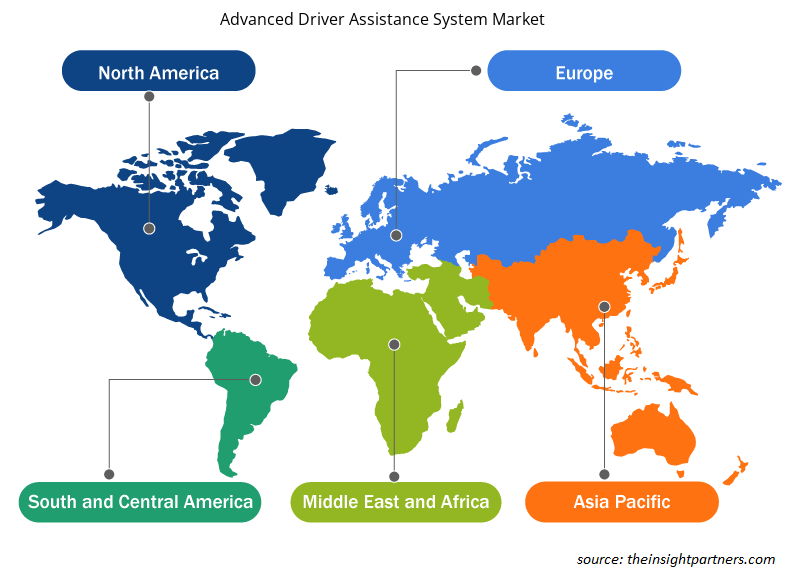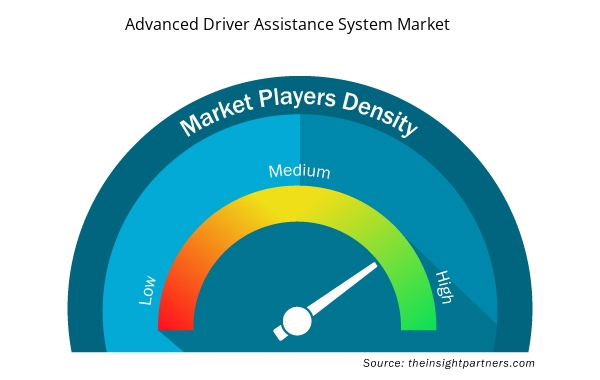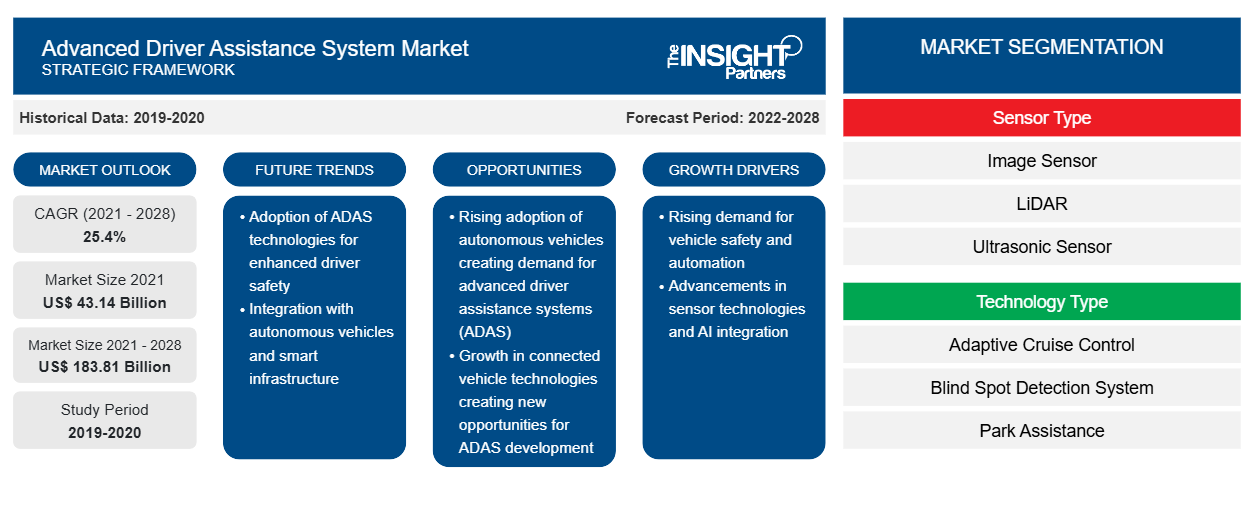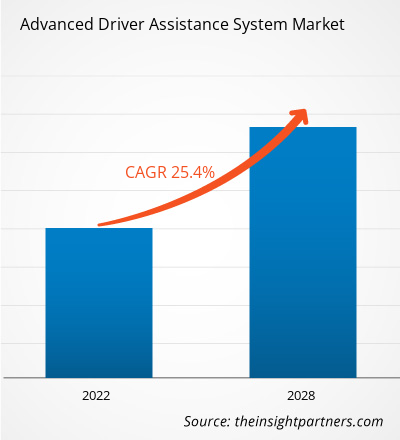[研究报告] 高级驾驶辅助系统(ADAS)市场预计将从 2021 年的 431.3844 亿美元增长到 2028 年的 1838.1484 亿美元;预计从 2022 年到 2028 年的复合年增长率为 25.4%。CAGR of 25.4% from 2022 to 2028.
分析师观点:
近年来,受技术进步、日益增长的安全问题以及对增强驾驶体验的追求推动,全球高级驾驶辅助系统市场经历了显著的增长和转型。这一充满活力的细分市场涵盖了各种技术和功能,以各种方式为驾驶员提供帮助,从提高安全性到提高便利性和舒适性。
市场增长的主要驱动力之一是人们对安全性的日益关注。随着道路交通事故继续对公共健康和安全构成重大威胁,高级驾驶辅助系统 (ADAS) 已变得至关重要。车道保持辅助、自适应巡航控制和自动紧急制动等功能已得到广泛采用,因为它们有助于降低因人为错误导致事故的风险。此外,先进的高级驾驶辅助系统 (ADAS) (ADAS) 的普及正在改变消费者与车辆的互动方式。这些系统依靠传感器、摄像头和机器学习算法为驾驶员提供实时反馈,使导航更容易。这些技术正在被整合到豪华车、中档和经济型汽车中,扩大其在各个消费者细分领域的影响力。
随着市场不断发展,它面临着一些挑战。ADAS 系统的复杂性可能导致成本增加,而且人们担心它们在所有条件下的可靠性。此外,随着这些系统收集和处理大量数据,数据隐私和网络安全问题变得越来越重要。
定制此报告以满足您的需求
您可以免费定制任何报告,包括本报告的部分内容、国家级分析、Excel 数据包,以及为初创企业和大学提供优惠和折扣
- 获取此报告的关键市场趋势。这个免费样品将包括数据分析,从市场趋势到估计和预测。
市场概况:
近年来,全球高级驾驶辅助系统市场大幅增长,这得益于对高级安全功能和增强驾驶体验的需求不断增长。高级驾驶辅助系统 (ADAS) 是一组功能和技术,旨在以各种方式辅助和增强驾驶员的能力,最终有助于实现更安全、更便捷的驾驶。
高级驾驶辅助系统 (ADAS) 的主要目标是通过降低事故发生的可能性(主要是人为失误造成的事故)来提高道路安全性。它们通过结合传感器、摄像头和雷达技术来实现这一目标,这些技术可以持续监控车辆周围环境并向驾驶员提供实时反馈。驾驶辅助系统的一些常见功能包括自适应巡航控制、车道保持辅助、自动紧急制动和盲点监控。这些系统协同工作,帮助驾驶员保持安全的跟车距离、保持在车道内并避免碰撞。
这些系统的运作以数据采集、处理和驱动为中心。车辆周围的各种传感器和摄像头收集有关道路状况、附近物体和车辆状态的数据。然后,车载计算机系统处理这些数据,使用复杂的算法对其进行解释并做出决策。例如,自适应巡航控制使用雷达测量与前方车辆的距离,调整速度以保持安全的跟车距离。同样,车道保持辅助系统使用摄像头检测车道标记,并在驾驶员开始偏离车道时轻轻操纵车辆以使其保持在车道内。
随着技术的进步,高级驾驶辅助系统 (ADAS) 的功能不断扩展,成为现代车辆不可或缺的一部分。虽然这些系统无疑提高了安全性和驾驶员的便利性,但仍存在一些挑战需要解决,包括实施成本、系统可靠性和网络安全问题。
市场驱动因素:
安全需求增加推动高级驾驶辅助系统市场增长
全球高级驾驶辅助系统市场呈上升趋势,这主要得益于监管部门对道路安全的日益重视。世界各国政府已经认识到高级驾驶辅助系统 (ADAS) 在减少事故和挽救生命方面的关键作用。各政府机构提供的统计数据强调了道路安全状况的重要性以及对先进安全技术的需求。在美国,国家公路交通安全管理局 (NHTSA) 报告称,2021 年机动车事故造成 42,939 人死亡。这些数字凸显了迫切需要创新解决方案来减轻经常导致道路事故的人为错误。因此,美国和许多其他国家的政府机构正在加紧努力,强制和鼓励在新车中集成高级驾驶辅助系统 (ADAS)。例如,2022 年,欧盟强制在乘用车和车辆中安装一些基本的高级驾驶辅助功能。这种监管推动,加上公众意识的增强和对更安全车辆的需求,是全球高级驾驶辅助系统市场增长的关键驱动力。汽车行业的未来与开发和整合这些先进的安全系统紧密结合,因为它们将继续减轻与道路事故相关的经济负担。
节段分析:
根据车辆类型,市场分为乘用车和商用车。其中,乘用车增长迅速,全球对豪华汽车生产的需求不断增长。此外,随着美国和印度等国人民可支配收入的激增,汽车销量不断增长,推动了市场增长。印度乘用车销量较上年同比增长约 25%,到 2022 年达到 380 万辆。此外,中国电动汽车的普及率不断提高是支持市场增长的另一个因素。根据中国汽车工业协会的数据,与 2021 年相比,中国电动汽车销量增长了 93.4%。
区域分析:
亚太地区的高级驾驶辅助系统 (ADAS) 市场正在经历持续增长,有几个因素促成了这一显著扩张。
亚太地区高级驾驶辅助系统市场加速增长的主要原因之一是该地区各国政府采取的积极主动立场。各国政府越来越认识到高级驾驶辅助系统 (ADAS) 在提高道路安全性和缓解许多国家快速城市化和人口增长带来的严峻交通挑战方面的关键作用。例如,在道路安全记录相对较好的日本,政府仍然积极推广高级驾驶辅助系统。日本国家警察厅一直在支持这些系统的开发和实施。日本推出了“联网汽车路线图”等举措,鼓励采用包括高级驾驶辅助系统在内的先进技术,以提高安全性并减少交通事故。这导致日本市场上配备高级驾驶辅助系统 (ADAS) 的车辆数量稳步增加。
此外,亚太地区汽车行业的持续增长也是推动市场增长的另一个因素。强大的消费者基础、不断增加的可支配收入以及电动汽车的普及率不断提高是支持该地区高级驾驶辅助系统增长的一些因素。
关键球员分析:
高级驾驶辅助系统市场分析包括大陆集团、采埃孚、Aptiv PLC、法雷奥、Hella Kgaa Hueck & Co.、罗伯特·博世有限公司、现代摩比斯、麦格纳国际、奥托立夫、电装株式会社等参与者。2023 年,保时捷与 Mobiley 合作,提供 2 级以上高级驾驶辅助系统。
高级驾驶辅助系统 (ADAS)
高级驾驶辅助系统市场区域洞察
Insight Partners 的分析师已详细解释了预测期内影响高级驾驶辅助系统市场的区域趋势和因素。本节还讨论了北美、欧洲、亚太地区、中东和非洲以及南美和中美洲的高级驾驶辅助系统市场细分和地理位置。

- 获取高级驾驶辅助系统市场的区域特定数据
高级驾驶辅助系统市场报告范围
| 报告属性 | 细节 |
|---|---|
| 2021 年市场规模 | 431.4亿美元 |
| 2028 年市场规模 | 1838.1亿美元 |
| 全球复合年增长率(2021 - 2028) | 25.4% |
| 史料 | 2019-2020 |
| 预测期 | 2022-2028 |
| 涵盖的领域 | 按传感器类型
|
| 覆盖地区和国家 | 北美
|
| 市场领导者和主要公司简介 |
|
高级驾驶辅助系统市场参与者密度:了解其对业务动态的影响
高级驾驶辅助系统市场正在快速增长,这得益于终端用户需求的不断增长,这些需求源于消费者偏好的不断变化、技术进步以及对产品优势的认识不断提高等因素。随着需求的增加,企业正在扩大其产品范围,进行创新以满足消费者的需求,并利用新兴趋势,从而进一步推动市场增长。
市场参与者密度是指在特定市场或行业内运营的企业或公司的分布情况。它表明在给定市场空间中,相对于其规模或总市场价值,有多少竞争对手(市场参与者)存在。
在高级驾驶辅助系统市场运营的主要公司有:
- 大陆汽车集团
- 赛普拉斯半导体公司
- First Sensor AG(TE Connectivity)
- 哈曼国际(三星集团)
- 日立制作所有限公司
免责声明:上面列出的公司没有按照任何特定顺序排列。

- 获取高级驾驶辅助系统市场顶级关键参与者概览
最新动态:
这些公司正在全球高级驾驶辅助系统市场采取多种战略,例如合作、伙伴关系、并购和新产品开发。以下列出了一些最近的关键市场发展:
- 2023年,大陆集团与安霸电子合作开发基于人工智能的端到端硬件和软件解决方案。
- 2023 年,通用汽车推出了驾驶辅助技术 Ultra Cruise。Ultra Cruise 结合使用摄像头、短程和长程雷达、挡风玻璃后面的 LiDAR、全新处理系统和驾驶员注意力系统来监控驾驶员的头部位置和与道路协调的眼睛。
- 历史分析(2 年)、基准年、预测(7 年)及复合年增长率
- PEST 和 SWOT 分析
- 市场规模价值/数量 - 全球、区域、国家
- 行业和竞争格局
- Excel 数据集



Report Coverage
Revenue forecast, Company Analysis, Industry landscape, Growth factors, and Trends

Segment Covered
This text is related
to segments covered.

Regional Scope
North America, Europe, Asia Pacific, Middle East & Africa, South & Central America

Country Scope
This text is related
to country scope.
常见问题
Asia Pacific dominated The Advanced driver assistance systems (ADAS) market in 2021 with a share of 46.1%; it would continue to dominate the market during the forecast period and account for 50.2% share by 2028
The driving factors impacting the Advanced driver assistance systems (ADAS) market are
I. Growing Demand for Safety and Driving Comfort Features
II. Rising Adoption of Integrated Radar and Camera Systems
The global advanced driver assistance systems (ADAS) market was valued at US$ 43,138.44 million in 2021
The global advanced driver assistance systems (ADAS) market size is projected to reach US$ 183,814.84 million by 2028.
The blind-spot detection segment led the advanced driver assistance systems (ADAS) market in 2021.
The key players holding the major market share of the advanced driver assistance systems (ADAS) market are Continental AG; Hitachi, ltd; Denso Corporation; Harman International; and NXP semiconductors.
The Future trends impacting the advanced driver assistance systems (ADAS) market are - Growing Demand for Embedded Vision Systems in Vehicles
APAC is the fastest-growing regional market in the global Advanced driver assistance systems (ADAS) market in 2021.
Trends and growth analysis reports related to Automotive and Transportation : READ MORE..
The List of Companies - Advanced Driver Assistance Systems (ADAS) Market
- Continental AG
- Cypress Semiconductor Corporation
- First Sensor AG (TE Connectivity)
- Harman International (Samsung Group)
- Hitachi, Ltd.
- MG Motor India Private Limited
- NVIDIA Corporation
- Robert Bosch GmbH
- Telefonaktiebolaget LM Ericsson
- Vector Informatik GmbH
The Insight Partners performs research in 4 major stages: Data Collection & Secondary Research, Primary Research, Data Analysis and Data Triangulation & Final Review.
- Data Collection and Secondary Research:
As a market research and consulting firm operating from a decade, we have published and advised several client across the globe. First step for any study will start with an assessment of currently available data and insights from existing reports. Further, historical and current market information is collected from Investor Presentations, Annual Reports, SEC Filings, etc., and other information related to company’s performance and market positioning are gathered from Paid Databases (Factiva, Hoovers, and Reuters) and various other publications available in public domain.
Several associations trade associates, technical forums, institutes, societies and organization are accessed to gain technical as well as market related insights through their publications such as research papers, blogs and press releases related to the studies are referred to get cues about the market. Further, white papers, journals, magazines, and other news articles published in last 3 years are scrutinized and analyzed to understand the current market trends.
- Primary Research:
The primarily interview analysis comprise of data obtained from industry participants interview and answers to survey questions gathered by in-house primary team.
For primary research, interviews are conducted with industry experts/CEOs/Marketing Managers/VPs/Subject Matter Experts from both demand and supply side to get a 360-degree view of the market. The primary team conducts several interviews based on the complexity of the markets to understand the various market trends and dynamics which makes research more credible and precise.
A typical research interview fulfils the following functions:
- Provides first-hand information on the market size, market trends, growth trends, competitive landscape, and outlook
- Validates and strengthens in-house secondary research findings
- Develops the analysis team’s expertise and market understanding
Primary research involves email interactions and telephone interviews for each market, category, segment, and sub-segment across geographies. The participants who typically take part in such a process include, but are not limited to:
- Industry participants: VPs, business development managers, market intelligence managers and national sales managers
- Outside experts: Valuation experts, research analysts and key opinion leaders specializing in the electronics and semiconductor industry.
Below is the breakup of our primary respondents by company, designation, and region:

Once we receive the confirmation from primary research sources or primary respondents, we finalize the base year market estimation and forecast the data as per the macroeconomic and microeconomic factors assessed during data collection.
- Data Analysis:
Once data is validated through both secondary as well as primary respondents, we finalize the market estimations by hypothesis formulation and factor analysis at regional and country level.
- Macro-Economic Factor Analysis:
We analyse macroeconomic indicators such the gross domestic product (GDP), increase in the demand for goods and services across industries, technological advancement, regional economic growth, governmental policies, the influence of COVID-19, PEST analysis, and other aspects. This analysis aids in setting benchmarks for various nations/regions and approximating market splits. Additionally, the general trend of the aforementioned components aid in determining the market's development possibilities.
- Country Level Data:
Various factors that are especially aligned to the country are taken into account to determine the market size for a certain area and country, including the presence of vendors, such as headquarters and offices, the country's GDP, demand patterns, and industry growth. To comprehend the market dynamics for the nation, a number of growth variables, inhibitors, application areas, and current market trends are researched. The aforementioned elements aid in determining the country's overall market's growth potential.
- Company Profile:
The “Table of Contents” is formulated by listing and analyzing more than 25 - 30 companies operating in the market ecosystem across geographies. However, we profile only 10 companies as a standard practice in our syndicate reports. These 10 companies comprise leading, emerging, and regional players. Nonetheless, our analysis is not restricted to the 10 listed companies, we also analyze other companies present in the market to develop a holistic view and understand the prevailing trends. The “Company Profiles” section in the report covers key facts, business description, products & services, financial information, SWOT analysis, and key developments. The financial information presented is extracted from the annual reports and official documents of the publicly listed companies. Upon collecting the information for the sections of respective companies, we verify them via various primary sources and then compile the data in respective company profiles. The company level information helps us in deriving the base number as well as in forecasting the market size.
- Developing Base Number:
Aggregation of sales statistics (2020-2022) and macro-economic factor, and other secondary and primary research insights are utilized to arrive at base number and related market shares for 2022. The data gaps are identified in this step and relevant market data is analyzed, collected from paid primary interviews or databases. On finalizing the base year market size, forecasts are developed on the basis of macro-economic, industry and market growth factors and company level analysis.
- Data Triangulation and Final Review:
The market findings and base year market size calculations are validated from supply as well as demand side. Demand side validations are based on macro-economic factor analysis and benchmarks for respective regions and countries. In case of supply side validations, revenues of major companies are estimated (in case not available) based on industry benchmark, approximate number of employees, product portfolio, and primary interviews revenues are gathered. Further revenue from target product/service segment is assessed to avoid overshooting of market statistics. In case of heavy deviations between supply and demand side values, all thes steps are repeated to achieve synchronization.
We follow an iterative model, wherein we share our research findings with Subject Matter Experts (SME’s) and Key Opinion Leaders (KOLs) until consensus view of the market is not formulated – this model negates any drastic deviation in the opinions of experts. Only validated and universally acceptable research findings are quoted in our reports.
We have important check points that we use to validate our research findings – which we call – data triangulation, where we validate the information, we generate from secondary sources with primary interviews and then we re-validate with our internal data bases and Subject matter experts. This comprehensive model enables us to deliver high quality, reliable data in shortest possible time.


 获取此报告的免费样本
获取此报告的免费样本